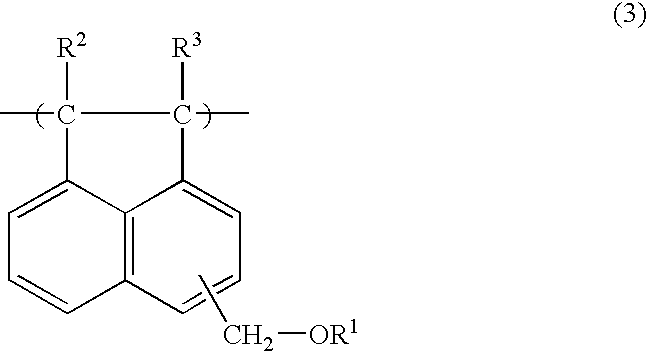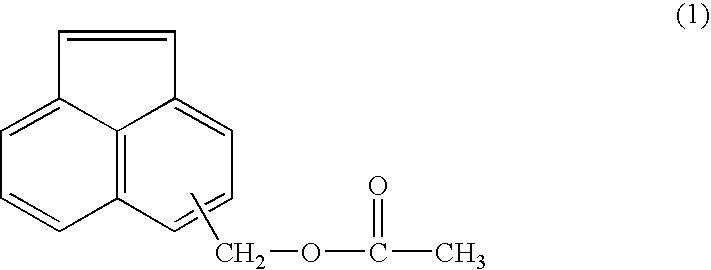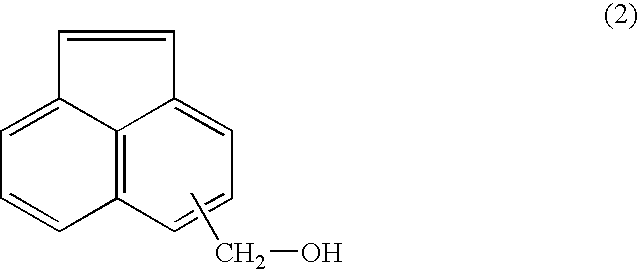Acenaphthylene derivative, polymer, and antireflection film-forming composition
a technology of acenaphthylene and derivatives, applied in the direction of photosensitive materials, instruments, photomechanical equipment, etc., can solve the problems of inability to precisely reproduce a fine resist pattern, inability to substitute acenaphthylene derivatives having aromatic rings, and inability to precisely reproduce fine resist patterns
- Summary
- Abstract
- Description
- Claims
- Application Information
AI Technical Summary
Problems solved by technology
Method used
Image
Examples
example 1
Synthesis of Acenaphthylene Derivative
Step 1
[0275]150 g of tin chloride was added dropwise to a solution of dichloromethyl methyl ether (70 g) in dichloroethane (300 g) while stirring at −5° C. under a dry atmosphere. Then, a solution of acenaphthene (77 g) in dichloroethane (300 g) was added. After stirring for two hours at room temperature, an aqueous solution of 5% calcium chloride was slowly added to the reaction solution. The organic phase was washed until the water phase becomes neutral and then removed. The solvent was evaporated to obtain 90.5 g of a pale yellow solid compound.
[0276]1H-NMR spectrum (solvent: deuterium chloroform, hereinafter the same) and IR spectrum were measured to identify the compound to be formyl acenaphthene. The measurement results were as follows.[0277]σ (unit ppm): 3.4 (CH2 group)[0278]7.3–8.8, 10.5 (CHO group)[0279]IR (unit cm−1): 1677 (C═O group)
Step 2
[0280]Formyl acenaphthene (73 g) obtained in Step 1 was dissolved in a mixed solvent of tetrahydr...
synthesis example 1
(Synthesis of 2-hydroxymethyl-6-vinylnaphthalene)
[0302]Methyl 6-bromo-2-naphthalene carboxylate (98 g) was dissolved in dimethoxyethane (2 1) and tetrakis(triphenylphosphine)palladium (44 g) was added in nitrogen atmosphere. The mixture was stirred for 30 minutes at room temperature. Potassium carbonate (52 g), water (1 1) and 2,4,6-trivinylcyclotriboroxane-pyridine complex (91 g) were added and the mixture was stirred for 24 hours while refluxing with heating. There action mixture was cooled to room temperature and treated with activated alumina to obtain methyl 2-vinyl-6-naphthalene carboxylate (77 g).
[0303]The methyl 2-vinyl-6-naphthalene carboxylate (30 g) was dissolved in tetrahydrofuran and 1 M diisobutylaluminum hydride (DIBAL-H) solution (400 ml) was added at −78° C. After confirming completion of the reaction with thin layer chromatography, the reaction mixture was treated with methanol and water, and extracted with ethyl acetate.
[0304]The organic layer was washed with brin...
preparation example 1
Preparation of Resist Composition Solution for ArF
[0317]A separable flask equipped with a reflux condenser was charged with 8-methyl-8-t-butoxycarbonylmethoxycarbonyl-tetracyclo[4.4.0.12,5.17,10]dodec-3-ene (29 parts), 8-methyl-8-hydroxytetracyclo[4.4.0.12,5.17,10]dodec-3-ene (10 parts), maleic anhydride (18 parts), 2,5-dimethyl-2,5-hexanedioldiacrylate (4 parts), t-dodecylmercaptan (1 part), azobisisobutylonitrile (4 parts), and 1,2-diethoxyethane (6 parts) in a nitrogen stream. A polymerization reaction was carried out at 70° C. for 6 hours. After the polymerization, the reaction mixture was poured into a large amount of a 1:1 (by weight) mixed solvent of n-hexane / i-propyl alcohol to cause the resin to coagulate. The coagulated resin was washed with the solvent several times and dried under vacuum to obtain a resin containing the structural units of the following formula (a), (b), or (c) respectively in the amount of 64 mol %, 18 mol %, and 18 mol %, and having Mw of 27,000 at a y...
PUM
| Property | Measurement | Unit |
|---|---|---|
| temperature | aaaaa | aaaaa |
| temperature | aaaaa | aaaaa |
| temperature | aaaaa | aaaaa |
Abstract
Description
Claims
Application Information
 Login to View More
Login to View More - R&D
- Intellectual Property
- Life Sciences
- Materials
- Tech Scout
- Unparalleled Data Quality
- Higher Quality Content
- 60% Fewer Hallucinations
Browse by: Latest US Patents, China's latest patents, Technical Efficacy Thesaurus, Application Domain, Technology Topic, Popular Technical Reports.
© 2025 PatSnap. All rights reserved.Legal|Privacy policy|Modern Slavery Act Transparency Statement|Sitemap|About US| Contact US: help@patsnap.com



